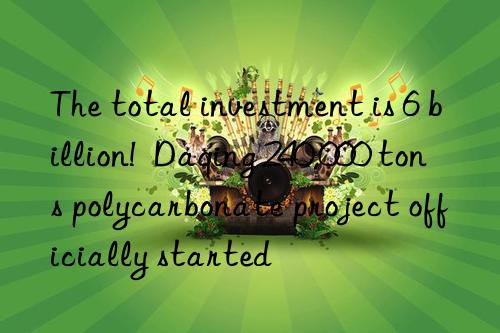
On April 21, Daqing City's key industrial projects in 2021 started intensively. From the beginning of the year to April 21, a total of 242 projects of various types have been resumed in Daqing City, with a total investment of 94.4 billion yuan and an annual planned investment of 41.76 billion yuan. The polycarbonate (PC) project with an investment of 6 billion is also among them.
It is reported that the project mainly includes 217,000 tons/year of phenol, 134,000 tons/year of acetone, 210,000 tons/year of bisphenol A, and 240,000 tons/year of polycarbonate. It is expected to be completed and put into operation in 2022.
The unveiling ceremony of the project was held on December 18, 2020. The start of construction marks the entry of the polycarbonate joint project with a total investment of 6 billion yuan into a substantive stage of operation.
It is reported that the polycarbonate joint project is based on the raw material supply advantages of Daqing's "oil head" and aims at the demand space of the "chemical tail" market. Using propylene as raw material, it follows "unified planning, overall implementation, step-by-step construction, and investment and construction for each mature one." To build a whole industrial chain of propylene-phenol & acetone-bisphenol A-polycarbonate, start the construction of 350,000 tons of phenol & acetone plant with an annual output, and simultaneously carry out the demonstration of bisphenol A and polycarbonate projects in the downstream of the industrial chain Work.
Polycarbonate or overcapacity
In recent years, the world's PC production and consumption demand have grown steadily. In 2019, the world's PC production capacity increased by 8.4% year-on-year, output and demand increased by 3.9% respectively, and the average operating rate of devices was 77.7%, a decrease of 3.4 percentage points from the previous year. The growth rate of PC production capacity is higher than the growth rate of consumption, which may face the risk of overcapacity.
The growth of demand in Asia has led to the rapid increase of the world's PC production capacity, and the world's PC production center has shifted to Asia, especially China and other Northeast Asian countries. In 2019, the production capacity of Northeast Asia, North America and Western Europe accounted for 85.5% of the world's total production capacity, 85.3% of production, and 80.2% of consumption. With the continuous increase of China's production capacity, Northeast Asia's PC production capacity has increased from 38.2% of the world's total production capacity in 2014 to 49.7% in 2019.
In 2018, the total international trade volume of PC reached 11.76 billion US dollars, and the total trade volume was 3.94 million tons, a year-on-year increase of 19.6% and 12.2% respectively. In terms of price, the world's average PC export price in 2018 was US$2,986.0/ton, a year-on-year increase of 6.9%. China, Mexico and Hong Kong are the world's major importers of PCs, and their combined imports account for about 44.4% of the world's total imports. South Korea, Thailand and the United States are the main exporting countries, and their combined export volume accounts for about 36.6% of the world's total export volume.
It is estimated that by 2021, the world's PC production capacity will reach 6.8 million tons/year. With the strengthening of environmental protection in various countries, the advantages of the non-phosgene melt transesterification polycondensation process are gradually highlighted. However, since this technology is not currently transferred to the outside world, the improved phosgene method will still be the main production method of PC in a certain period of time in the future.
In the future, PC consumption in the world will continue to grow steadily, and the Asian region will be the main consumption growth point. According to the consumption structure, in the future, film/sheet, electronics/electricity, automobiles, appliances/household goods will still be the main consumption areas of PCs in the world, among which the consumption of electronics/electrical appliances will continue to grow, while the consumption of optical media will continue to grow. volume will continue to decrease.



 微信扫一扫打赏
微信扫一扫打赏
